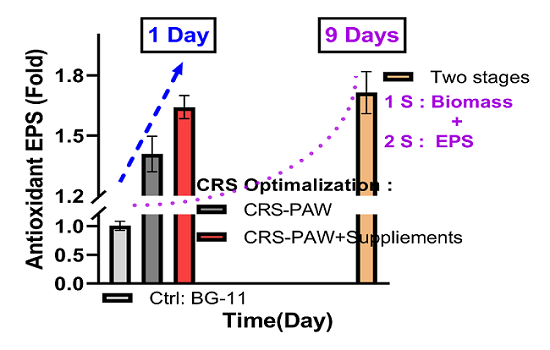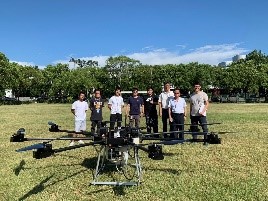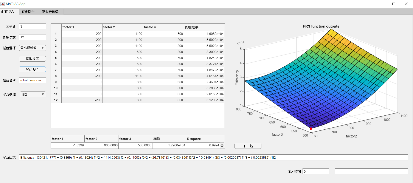Program Results
Global optimization of engineering and bio-medical systems with Complex System Response platform
Introduction to the event
OBJECTIVE
Global optimization of engineering and bio-medical complex systems with a game-changing Complex System Response (CSR) platform.
INTRODUCTION
More than a decade ago, we were interested in optimizing drug-dose of combinatorial drug to improve the therapeutic outcome. The drugs intact with diseased cellular components at the molecular level. However, disease is a system phenomenon. The science based of a biological system is on the field of knowledge of complex systems [Science Vol. 284, April 2, 1999, Science Vol. 325, July 24, 2009]. A complex system can be defined as a large number of interacting components, inputs, that self-organize and give rise to an emerging complex collective behavior, output.
In the first experiment, the ATP level, phenotypic output, of a non-small-cell-lung cancer line, A549, under the treatment of a three-drug combination, AG490, U0126, and indirubin-3’-monoxime (1-3-M), inputs of drug molecules with cellular molecules, was found to be linked by an second order non-linear functions, Complex System Response (CSR, previously named as PRS) function. The CSR function is as follows.
In the biological complex systems, the CSR function was validated in more than 30 disease models in cell line, animal, and clinical trials. As the CSR platform is based on mechanism-free approach and holds for physical complex system. During the first year of the Yu-Shan program, CSR platform has been successfully demonstrated in global optimizations of ME/EE manufacturing and antioxidant production projects.
ACCOMPLISHMENTS
Project 1: Facilitate the antioxidant EPS of Spirulina.sp using CSR approach
Team members: Ting-Yu Pan, Rong-Shing Chang, Chi-Shuo Chen, Jeffrey Da-Jeng Yao*
Goal: To Enhance the antioxidant EPS production of microalgae by applying the Complex System Response (CSR) platform, the global optimal output of can be rapidly identified by orders of magnitude savings in time, effort, and costs.
Findings:CSR platform enables us to optimize a huge search space with multiple parameters. For the first time, we added plasma-activated water (3 factors) and supplement (3 factors) to the BG-11 culture medium and found the optimal parameter-concentration combination. Yield rate of antioxidant EPS of Spirulina.sp was increased by 9 times.

Project 2: Optimization of adaptive thermal-balance control parameters for ultra-high precision machinery by using CSR
Team members: Ming-Tsang Lee (PI), Li-Chiao Mo, Chuan-Feng Lee
Goal: The technical goal of the project is to develop a model for adaptively controlling the temperature regulators on a machine tool to maintain its accuracy at the tool cutting point (TCP) during operation. By applying the Complex System Response (CSR) platform, the global optimal output can be rapidly identified by order of magnitude savings in time, effort, and costs.
Findings: By applying the CSR platform, a set of optimized parameters for temperature regulators on an ultrasonic machining center was developed with only 17 experiments in comparison to the need of more than 45 experiments if using other conventional techniques. This model built by CSR demonstrated a ±1 μm accuracy of the TCP displacement during a three-hours real test, which corresponds a nearly 70% improvement on the thermal-tilting error of the machine tool.
Project 3: Optimized Learning Strategy of the Brain
Team members: Li-An Chu (PI), Lin-Hui Yen, Yung-Chin Lu, Pei-Chun Chen
Goal: There are tens of thousands of learning strategies in the market. However, these training strategies often rely on try-and-error-based studies, which is far from optimization. By applying the Complex System Response (CSR) platform, the global optimal output can be rapidly identified by orders of magnitude savings in time, effort, and costs.
Findings: After conducting behavioral training experiments, it has been confirmed that using CSR optimization to train fruit flies with the experimental parameter yields an average actual performance score of 82.35. This is remarkably close to the CSR prediction of 84.73 points. This result demonstrates that through CSR optimization, it is possible to effectively identify the optimal brain training pattern, with a high level of reproducibility in comparison to the actual outcomes.
Project 4: Optimization of insulators cleaning parameters
Team members: Group E, MMSL, ITRI, Jason Chen, Mike Wen, Jose Felipe Manosalvas Banchon
Goal:
1. UAVs are used to clean high-voltage tower insulators in the air. This study proposes a closed-loop control method for targeting objects, which can still be tracked and accurately cleaned after the target is obscured by water mist.
2. By applying the complex system response (CSR) platform, it is expected to find the best stability control motor input under strong wind disturbance. Compared to human piloting, using complex system response (CSR) platform can save a lot of training time (>1000 hrs for qualified pilot) and personnel risk.
Findings: A large UAV with a wheelbase of 3m is used to carry a 30L water tank for field test. Using the Snipper approach at a distance of 2.5m from the insulator can accurately clean the target and continue to clean the target under the shadow of water mist.

Chih-Ming Ho – Group picture after the drone flight test of cleaning insulator of electrical power tower
Project 5: Application of CSR (Complex System Response) in the study of variation analysis of self-driving brake modules
Team members: Group D, MMSL, ITRI, Kelvin Chen, Chandler Ho
Goal: The brake module of the self-driving car has been braking for a long time during the obstacle avoidance process, resulting in performance variation. Therefore, the variability of the braking module is found through CSR, and the relative variation of the braking module reaches a condition (braking distance errors > 30% is more than 3 times), then the decision-making layer can automatically adjust the braking depth command.
Tests:
- There are three influencing factors, including deceleration, vehicle speed, and vehicle weight.
- The experiment will be carred out in two-stages.
- The first stage focuses on deceleration and vehicle speed; the second-stage focuses on deceleration, vehicle speed and vehicle weight.
- A 5-ton logistics vehicle is used as the experimental target vehicle.
- The first stage of experimentation has been carried out. Data processing is on going.
Project 6: Light Alloy Warm Forming Technology Development
Team members : Group G, MMSL, ITRI, Greg Tsai, Ning-Yuan Lyu, Hsuan-Yu Huang
Goal:
- Optimizing production efficiency within acceptable tolerances.
- By applying the Complex System Response (CSR) platform, in stamping applications, the time spent on blindly searching for process parameters can be reduced, thereby reducing trial and error costs (materials and labor) and quickly finding the desired optimal process parameters.
Accomplishments:
- In actual stamping experiments, the thinning ratio is used as the efficacy value, and material temperature and vibration count are used as factors. The results show that the accuracy of CSR prediction results compared to actual stamping results is as high as 83.95%.
- In simulated stamping experiments, the minimum thickness is used as the efficacy value, and material temperature, vibration count, and vibration speed are used as factors. The results show that CSR can provide process parameters that meet tolerance conditions to find the optimal production efficiency (vibration speed), and the accuracy compared to simulated stamping is as high as 96.92%.
Project 7: Nanofluid parameter design
Team members: Group K, MMSL, ITRI, Ya-Chi Ho, Tsai-Liang Wu, En-Lan Hu
Objective: Use CSR to optimize the parameters of nanofluids in heat pipes, gravity heat pipes, and siphon heat pipes. Graphene and Naimi fluids are self-made by the Machinery Institute of ITRI. The parameters include: the weight percentage of nanofluid (graphene); the weight percentage of dispersant, in order to allow graphene to perform heat exchange in the fluid more uniformly. The last contains the proportion of water injected. The first target value is the maximum heat transfer, how much heat can be taken away per unit volume; the second target is the heat transfer coefficient, so that the temperature inside the heat pipe can be uniform.
Findings: Preliminary CSR tests were carried out to effectively find out the weight percentage of nanofluid, the weight percent of dispersant, and the water injection ratio of nanofluid into the heat pipe. Among them, graphene nanofluid can be found in CSR and fitted with dispersant or water injection, and a set of surface equations can be found. In the future, these surface equations will be used to optimize the design of the maximum heat transfer and thermal conductivity of nanofluids.
Project 8: Coating process optimization and characteristics research
Team members: Group M1, MMSL, ITRI, Wen-Jun Chen, Shih-Chin Lin, Yi-Jiun Lin, Ching-Chiun Wang
Goals:
- This project aims at PECVD silicon nitride thin film optimizing analysis of process parameters (RF power, chamber pressure, chamber temperature, ammonia/silane flow rate ratio and total reaction gas flow rate) for film quality and dielectric properties by the application of complex system response (CSR) platform.
- By applying the complex system response (CSR) platform, compared with the traditional trial and error method, the optimum point of film quality and dielectric properties within the parameter range can be rapidly identified by orders of magnitude savings in time( 12 times, from 3-6 months to 2 weeks), experiments number( twice times, numbers from 30-50 to 26), effort, and costs.
Findings: In the low-temperature PECVD silicon nitride thin film process, through the optimization analysis of the complex system response (CSR) platform, the highest deposition rate and the lowest impurity content in the film was successfully found.
In the high-temperature PECVD silicon nitride thin film process, the range of process parameters has been determined, and it is expected to conduct experiments according to the experimental design table to optimize the analysis of film deposition rate and residual stress.
Project 9: Copper Electroplating for Filling High Aspect Ratio Through Glass Vias
Team members: Group M2, MMSL, ITRI, Yiu-Hsiang Chang, Meng-Chi Huang, Yu-Ting Fu
Goal:
- The target of the project is to obtain an optimal parameter combination which forms the bridge in the center of through glass vias (TGVs) the fastest with least probability of generating defect by using complex system response (CSR) with five parameters – current density, chloride ion concentration, additives (accelerator, suppressor and leveler) concentration. By the application of CSR, we are able to obtain the parameter combination to form bridges in the center of TGVs without defect in the shortest time. Comparing to traditional trial and error method, the experiments spend less months of time, effort and costs.
- The target is to obtain an optimal parameter combination which fills up the TGVs the fastest by using complex system response (CSR) with two parameters – current density and cathode rotation speed.By the application of CSR, we are able to obtain the parameter combination to fill up TGVs in the shortest time. Comparing to traditional trial and error method, the experiments spend less weeks of time, effort and costs.
Findings:
- By the analysis of complex system response (CSR), we successfully obtained the parameter combination to form the bridges in TGVs without defect in the shortest time, and finished verification experiment.
- We expect to finish the experiments from experimental design table and analyzing with complex system response (CSR) to obtain the parameter combination to fill up TGVs in the shortest time.
Project 10: Optimal Torque of Robot by CSR Algorithm, Robot Inverse Kinematic by CSR Algorithm
Team members : Group Q, MMSL, ITRI, Lance TSAI, Tien-Yun Chi, Jack Hsu
Goal:
- In the past, the pursuit of robotic arm has always been the shortest path, but the shortest path may not be the most energy-efficient. Therefore, this study aims to find the minimum torque path for each axis of the robotic arm. Since motor torque corresponds to energy consumption, the ultimate goal of this study is to optimize the power output of the robotic arm operation by finding the path of minimum torque.
- Robots often need to spend a lot of time performing inverse kinematics calculations for redundant degrees of freedom robots. The purpose of this research is to use CSR algorithm to try to shorten the inverse kinematics calculation time.
Findings:
- Find a set of optimal solutions and continue to verify.
- Try to find out if robot inverse kinematics is a complex system.
